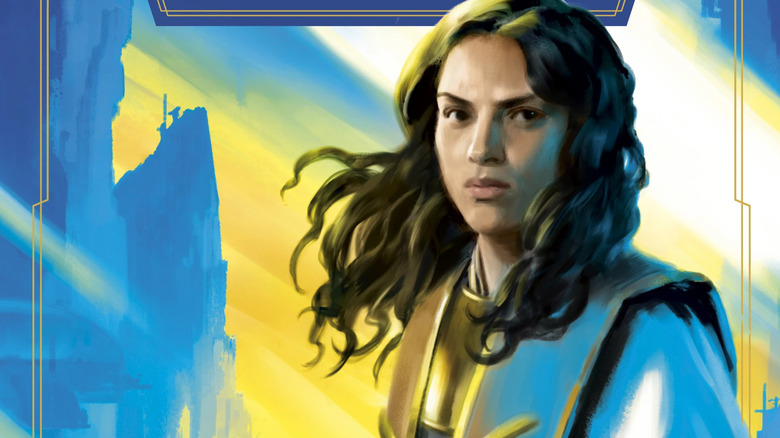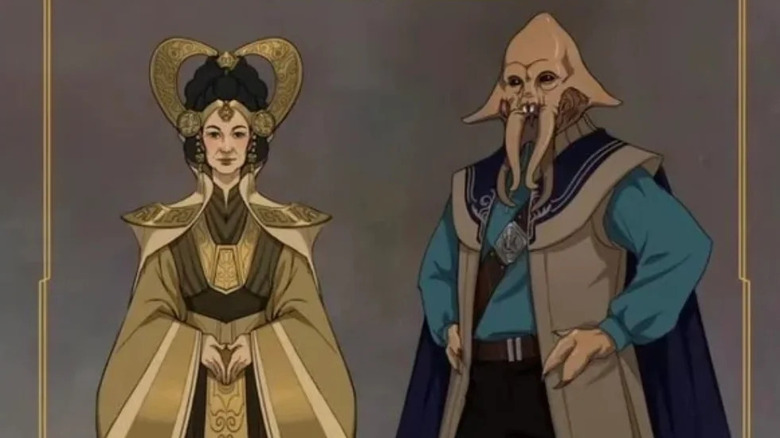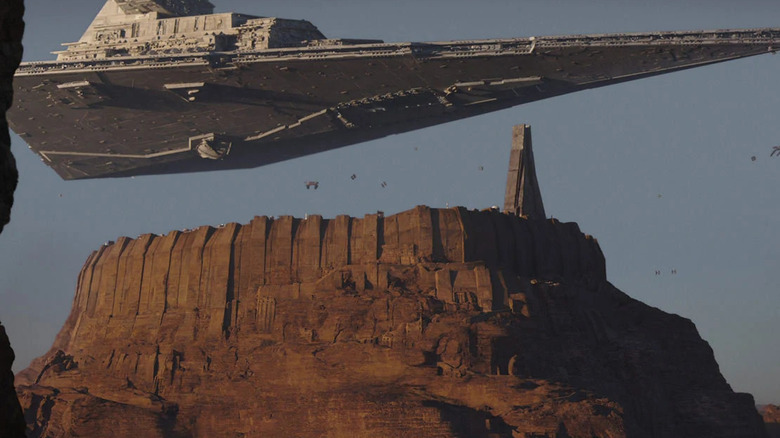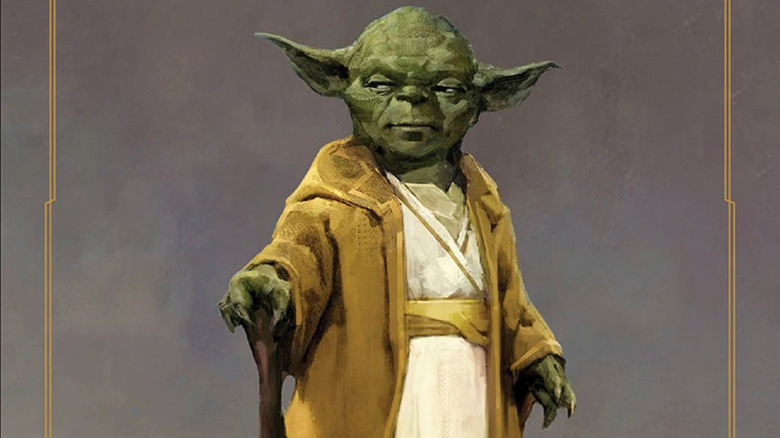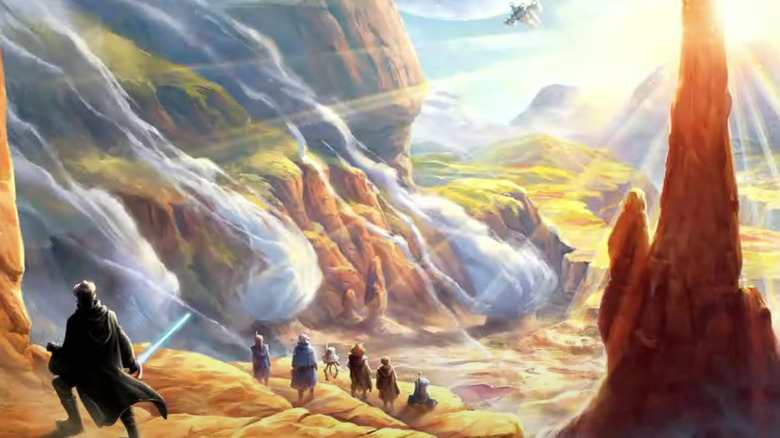The High Republic: Convergence Brings Social Justice To The Forefront Of Star Wars
Spoilers for "The High Republic: Convergence" follow.
Author Zoraida Cordova enters the world of "The High Republic" with her novel "Star Wars: The High Republic: Convergence," the first adult novel in the second phase of "The High Republic." "The High Republic" is Lucasfilm's "Star Wars" publishing initiative that is set a couple of hundred years, give or take, further back than "The Phantom Menace." It's a much more frontier look at the galaxy before the decay of bureaucracy instigated by Palpatine sets in. The Jedi are optimists and, essentially, cowboys on the fringe of the Republic, doing good where they can and fighting evil where they can find it. The era has many tests for the Jedi, though, and there are dangers lurking around every corner.
In "Convergence" we're introduced to a twinned pair of worlds, Eiram and E'ronoh, locked in what they call a Forever War. They're symbiotically linked for survival, but one thrives while the other is stricken with drought and hardship. It's a tense situation as each planet has taken hard losses and blamed the other side. "Peace is a choice," Mollo, a Quarren Chancellor of the Republic tells them. But they can't quite get there on their own, so it's left to the next generation of heirs in the royal families to fix.
All the while, a young Jedi named Gella Nattai, is part of a delegation of Jedi trying to help negotiate a peace between the planets. She ends up with the young heirs of both planets on a mission to save their twin planets, alongside Axel Greylark, the son of another Chancellor of the Republic.
Will they be able to find a workable peace for their people?
Politics and intrigue
One of the best parts of the book is the way Cordova weaves politics and intrigue into the story. It feels very frustrating to watch both sides blame each other when they could just stop and reassess. But that would require trust they don't have and it creates a potent message for those of us trying to navigate the political landscape of our day. In fact, all of the books in this wave of "The High Republic" have had strong messages of social justice wound into their narratives and they're stronger for it. There are definitely environmental themes in this book, as there were in the previous "High Republic" release, "Quest for the Hidden City." But this really excels in putting the onus on the next generation to take action, even actions previous generations would nix or discard because of their absurd adherence to traditionalism.
When I finished reading this book, I felt like that cause of peace and helping people mattered in my real life. It made me look around wondering what more I can do to help. And that's the mark of a good story, one that moves a reader to action and stirs feelings in them.
This importance of Jedha
For "Star Wars" fans looking for additions to the lore, there was one thing that I don't recall seeing anywhere else in the canon so far that they will find important, at least at this point in the timeline. There's mention of a group of Force-sensitive children that were rescued at one point by the Jedi. These children all had abilities with the Force, but were determined to be too old to join the Jedi Order. Instead, they were all taken to Jedha to be adopted by other orders that could be found there.
This raises two ideas. The first is the assumption that we will be heading to Jedha at some point during the second phase of "The High Republic." They have mentioned it and talked about it in a lot of ways too many times through the three book releases of "The High Republic" so far to leave it as just a faraway place that we never see more of.
The second idea it raises is an alternate path forward for Anakin Skywalker. Was this common practice among the Jedi who had children brought before them? If they were all deemed too old to begin the training—as Anakin initially was—would they have forced Qui-Gon Jinn to deposit Anakin on Jedha, to be adopted by whichever order would have him? Is there an alternate version of history where Baze and Chirrut helped raise Anakin as one of the Guardians of the Whills?
It's an interesting thought worth exploring and I hope future installments of "The High Republic" delve into this idea.
Details to watch out for
It's interesting to see how restrained the references to other parts of the "Star Wars" universe are in this wave of "The High Republic," but it makes sense. This is so far divorced from the current era of "Star Wars", it makes sense that the connections would be few and far between. That being said, "Convergence" does have some touchstones to the future of "Star Wars" and four that will put a smile on the faces of those loving this current iteration of "Star Wars" television.
The first is the use of the swearing-like phrase "dank farrik", which was popularized by "The Mandalorian." It's uttered here and brings a smile. For fans of the animated series "Star Wars Rebels", there are jogan fruits throughout the book and references to one character's allergy to them. The planet Tawl gets a mention in passing, and that was interesting because the first utterance of Tawl was on the "Kenobi" show. That's where Obi-Wan said that he and Leia were from—farmers from Tawl visiting a different planet.
For fans of Andor, we get to see a little bit of a new window into Chandrilan dating customs, which are a hot topic at the moment, thanks to Mon Mothma and the situation with her daughter.
I was delighted to see Alex Greylark familiar with the criminally misunderstood locale of Canto Bight, stretching the reputation of that hive of scum and villainy further back into the timeline.
But one of the biggest touchstones this book does give us as we look at it through the lens of the past is that Yoda is still, at this point in the timeline, training younglings. He was a key influence on our main Jedi, Gella Nettai, and even though he doesn't appear in the book, there are many anecdotes or bits of wisdom that he brings. There's one particular bit of advice that he gave Gella as a youngling that resonates with her throughout her life and will resonate through me alongside other great nuggets of Yoda's wisdom.
Overall
Zoraida Cordova crafted a complicated but compelling narrative, showing the difficulties in achieving peace among those who simply don't want it. What are those things that motivate people to eschew peace? What are the prejudices they carry? She's able to actually explore these themes against the backdrop of a rollicking "Star Wars" adventure, replete with chases, escapes, lightsaber battles, and true love. It's a delicate feat, but I think she managed it well.
But she also pushed forward the overarching narrative that's been threading through these early books of the "The High Republic." The Path of the Open Hand — the precursor to the big bad faction in phase one, the Nihil — is hard at work, seeming peaceful on one end, but a vicious and violent cult on the other. It's fascinating to watch the pieces of their history fall into place and makes one wonder how they become what they do in the future.
For now, Cordova was an excellent addition to the roster of authors working in "The High Republic" and I hope we see more "Star Wars" from her.
"Star Wars: Convergence" is available now at bookstores everywhere.
